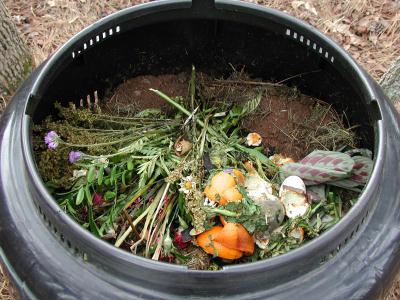Since I just got very first composter about a week and a half ago, I thought I’d share some of my research and chronicle my composting journey here on the blog. I’m going to start with some of the basic wuestion that I asked when I was looking to join the composting corps. So here goes:
What is composting?
The most basic definition is decayed organic material used as plant fertilizer
What is the Purpose of Compost?
The organic matter in compost helps plants root systems grow stronger and produce a bigger yield. (Bigger flowers, fruit, vegetables, herbs or whatever you’re growing). It does this because decayed organic matter has all of the same essential nutrients as what you’re trying to grow out of it. In turn the healthy plants that are grown help clean the air and keep the soil healthy, which makes air quality better, which makes what we breathe and eat from the garden better. (you see where I’m going with this right?) Also, you’ll save water and money, because compost retains water longer so you have to water less often, and you’ll need to use less garden soil once you really get going.

Yard waste, vegetables, fruit, grass clippings, remains of garden plants, coffee grounds and teabags. All of these items must not be heavily seasoned or covered in oil. (That leftover salad? Not so much). YOU CANNOT COMPOST meat, bones, blood, milk or dairy products, household trash, rice, animal feces, diseased plants, oil of any kind and walnuts.(They apparently are made up of a compound that is toxic to some plants.)
How Does the Compost Breakdown?
The compost pile is a mini bacterial farm. (Don’t worry, it’s the good kind). Everything organic has a carbon to nitrogen ratio or C:N ratio. Scientists believe that a C:N ratio of 30:1 is ideal for activating good bacteria into breaking down the pile. If there too much carbon, then decomp slows down, and if nitrogen is too high, you’ll just have a stinky pile. (Yuck!) The closer your mix is to that 30:1 ratio, the quicker it will breakdown, the less it will smell, and the more rich the compost soil will be. Don’t worry, there’s no math involved, all you have to do is make sure your pile is pretty much balanced with “brown” waste (i.e.- ashes, wood, corn stalks, leaves, fruit waste, sawdust) and “green” waste. (i.e. – weeds, grass clippings, seaweed, vegetable scraps, coffee grounds). Moisture and aeration play a part in the breakdown process as well. Later, insects, microscopic organisms and worms take over the breakdown process by eating and secreting their way through the pile (I know, I know, it’s gross but it’s worth it I swear).
When Can I Compost?
Year round. No really. Even in the winter. We’re dealing with nature here folks, and what happens in winter in nature? Animals hibernate, some insects bury themselves, plants drop their leaves as insulation, and go undergound to sleep until spring. But they’re still alive, just operating at 30% capacity. Well, when the temperature drops, the composting process slows down considerably, but it still works basically the same way nature does and apparently there’s pretty simple ways of making your compost last the winter.
In the next part of this series I’ll go into the various containers that you can use to compost and how to use ‘em. Please comment with any questions you have. I’m a novice at this, but I might be able to help, or at least point you in the direction of someone who can.
*********************
Sources:
Composting 101
Cornell Univerisity Compost Brochure

